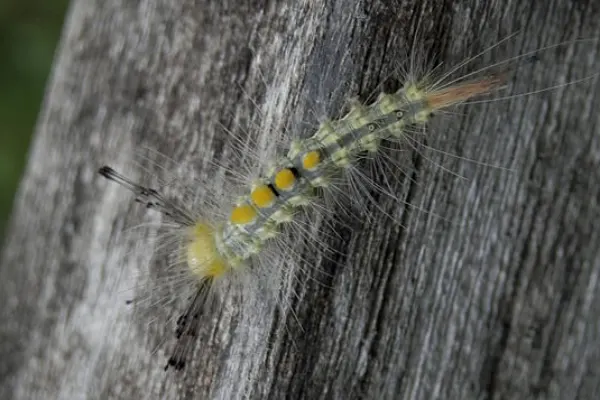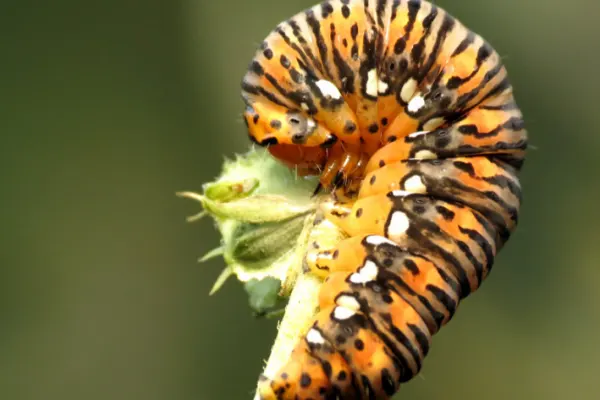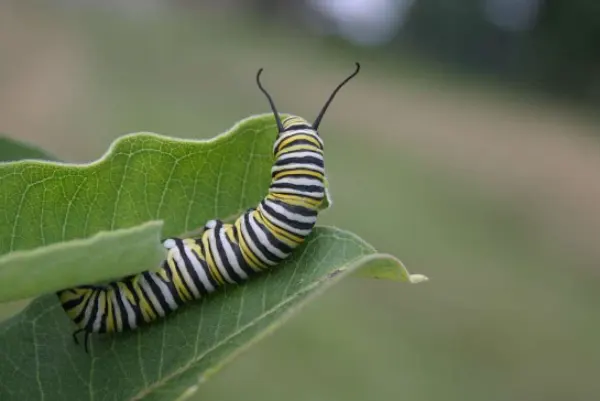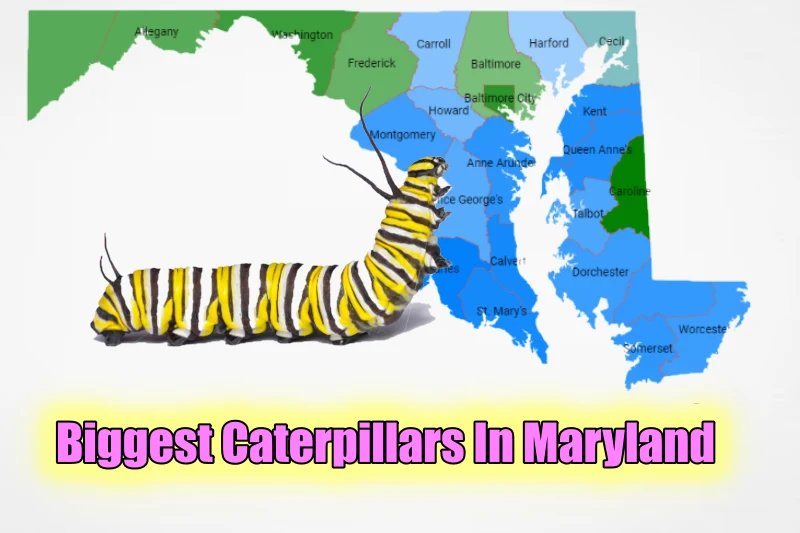As we all know, Maryland is famous for fishing and horse farms. But do you know one more thing is there that is often noticed by people? There are many caterpillars in Maryland that you can find crawling on the bark, leaves, and trees. and here we are going to look at some of them based on their body length.
Here we go.
Top 15 Biggest Caterpillars In Maryland
15. Monkey Slug Caterpillar
| Scientific name | Phobetron pithecium |
| Size | 15-25 mm |
| Identification | Nine pairs of legs |
One of the caterpillars in Maryland is the monkey slug caterpillar. This caterpillar has nine pairs of curly projections, or tubercles, each densely covered in hairs.
It has nine pairs of legs and prolegs, which are reduced to suction cups. Further, the arms or tubercles can fall off without harming the larva, aiding in defense.
Moreover, the larvae are 1.5–2.5 centimeters in length and are not a significant agricultural threat but are common in orchards. Also, they are solitary and not a significant agricultural threat.
14. Definite Tussock Moth Caterpillar

| Scientific name | Orgyia definita |
| Size | Approx. 20 mm |
| Identification | Yellow head & spikes |
In 1865, the world learned about a new species of caterpillar with the help of the Alpheus spring Packard. This species is commonly found in the landscape of Maryland and different regions of the United States.
The caterpillar has a yellow head and a prothoracic plate. You can also identify this caterpillar by the white hairs covering its body and its pale yellow verrucae.
13. White Furcula Moth Caterpillar
| Scientific name | Furcula borealis |
| Size | 20-25 mm |
| Identification | Two horn-like projections from the shoulders |
The White Furcula caterpillar has two tail-like projections and appears almost capable of stinging, possibly as a deterrent tool.
As it matures, it changes color, with young ones appearing black or purple with yellow bands and older ones appearing green with brown saddles.
Moreover, the head may appear flat when tucked in due to two horn-like projections from the shoulders. The front end is boxy and wider than the rear. Further, these caterpillars feed on aspen, cherry, poplar, and willow trees.
12. Woolly Bear Caterpillar

| Scientific name | Pyrrharctia isabella |
| Size | 22-26 mm |
| Identification | Brown and black hair covering its whole body |
Another caterpillar on the list of caterpillars in Maryland is Pyrrharctia isabella. You might know it by the name of a banded woolly bear or woolly worm.
This caterpillar turns into a moth, which is commonly seen flying in the United States and southern Canada.
If you are wondering how to identify this caterpillar, let us tell you that the larva has brown and black hair covering its whole body. The adult caterpillar has yellowish-orange thoraces, small heads, and bright reddish-orange forelegs.
After a long journey, this caterpillar turned into an Isabella tiger moth. It survives freezing by producing a cryoprotectant in its tissues.
Larval setae do not inject venom or cause irritation, injury, inflammation, or swelling. So stay conscious when you see this caterpillar around you.
11. Puss Moth Caterpillar
| Scientific name | Megalopyge opercularis |
| Size | 25 mm |
| Identification | Bright orange streak running longitudinally |
If you see Megalopyge opercularis, then stay away from it. It is more dangerous than its cute look. This caterpillar converts into a moth in the Megalopygidae family.
You might hear some other name for it; it is also known by names such as southern flannel moth, puss caterpillar, asp, fire caterpillar, woolly slug, opossum bug, puss moth, tree asp, or asp caterpillar.
Furthermore, its inch-long larva is covered in hair-like setae, resembling a Persian cat. Its color ranges from grayish white to dark charcoal gray, with a bright orange streak running longitudinally.
Also, early-stage larvae have curly fur, while the middle instar has a disheveled appearance. The larva’s fur contains venomous spines that cause painful skin reactions.
10. Stinging Rose Caterpillar
| Scientific name | Parasa indetermina |
| Size | 23-30 mm |
| Identification | Smaller spiny bumps along each side |
The stinging rose caterpillar is scientifically known as Parasa indetermina. Talking about its length, the caterpillar is slightly less than an inch long. But this little friend can cause a lot of pain if it stings.
If we confounded it to identify it, then we saw a caterpillar with seven pairs of spine-covered “horns” and smaller spiny bumps along each side. Also, the spines are hollow and filled with urticating fluid, which releases the fluid, causing a painful sting.
Furthermore, the caterpillar has white, black, orange, and red lines running along its back and sides. Female and male moths emerge in mid-summer, mate, and lay eggs for tiny caterpillars.
Moreover, the caterpillars feed, molt, and grow, hiding on the lower surface of their host plant leaves. In later summer, they spin a brown capsule-like cocoon, which they spend in the fall, winter, and spring.
9. Gold Moth Caterpillar

| Scientific name | Basilodes pepita |
| Size | Approx. 40 mm |
| Identification | Black patterns around its body like a tiger |
The gold moth caterpillar is observed to have distinctive color patterns. Mostly, it is seen in colors like orange, black, and white. Also, you can identify it through its distinctive pale and black rings around its body.
Other than that, it also had white spots on its body. Further, the head of the caterpillar is orange in color. The maximum length of the body is around 40 mm.
8. Large Tolype Moth Caterpillar
| Scientific name | Tolype velleda |
| Size | Approx. 45 mm |
| Identification | White fur on their thorax, legs |
The Large Tolype Moth caterpillar is a large, white moth with a flap on its prolegs, which are fleshy legs that disappear after development.
Moreover, adults have a heap of white fur on their thorax, legs, and antennae, with a dark mohawk on the thorax and gray or taupe wings with thin white, wavy lines crossing them.
Further, females are paler than males, and the moth is medium to large. Furthermore, it feeds on the leaves and soft foliage of various trees and shrubs, with feeding most active in the summer.
7. Monarch Caterpillar

| Scientific name | Danaus plexippus |
| Size | 45-50 mm |
| Identification | White dots on the prolegs |
The caterpillar has five stages, each lasting 3 to 5 days. The first instar is pale green or grayish-white, shiny, and almost translucent, with a large black head. Do you know the caterpillar feeds on milkweed in a circular motion, often leaving a characteristic arc-shaped hole in the leaf?
Further, the second instar develops a pattern of white, yellow, and black transverse bands, with a yellow triangle on the head and two sets of yellow bands around it.
Moreover, the third instar has more distinct bands, and two pairs of tentacles grow.
Furthermore, the fourth instar has white spots on the prolegs near its back, and the fifth instar has a more complex banding pattern and white dots on the prolegs.
As the caterpillar completes its growth, it is 4.5 to 5 cm long and 7 to 8 mm wide. The fourth- and fifth-instar stages showed signs of aggressive behavior with lower food availability.
6. Pipevine Swallowtail Caterpillar
| Scientific name | Battus philenor |
| Size | Approx. 50 mm |
| Identification | Bright orange spots on tubercles |
Pipevine swallowtail caterpillars, resembling Alice in Wonderland, are purple with orange spots and long filamentous body protrusions. They are toxic to birds and animals, and they retain this trait when they become butterflies.
Larvae, ranging from dark brown to black, have bright orange spots on tubercles and are elongated into filaments.
They eat leaves from their host plants and move to new ones as food sources deplete. They identify vertical plants using filaments, feed, and wander for several weeks before finding an isolated spot to pupate.
5. Spiny Elm Caterpillar
| Scientific name | Nymphalis antiopa |
| Size | Approx. 50 mm |
| Identification | Creamy yellow band |
The spiny elm caterpillar, Nymphalis antiopa, is found in northern Illinois and is known as the mourning cloak butterfly. It feeds on various trees, including elm and willow.
The immature form of the butterfly has a wingspan of two to three inches and is moderately sized.
It has dark brown wings with blue spots and a creamy yellow band. This butterfly overwinters as an adult, making it one of the first to appear in early spring. This year, several sightings were reported in early April.
4. Eastern Tiger Swallowtail Caterpillar
| Scientific name | Papilio glaucus |
| Size | Approx. 55 mm |
| Identification | The abdomen is spotted transversely in light blue |
Another caterpillar on the list of caterpillars in Maryland is the Eastern Tiger Swallowtail Caterpillar. The caterpillar eats the leaves of a host plant and rests on a silk pad. Do you know? It has three brown instars and a large white saddle on the abdomen.
Furthermore, after molting to the fourth instar, it becomes green. Moreover, the swollen thorax has two black, yellow, and blue eyespots, smaller than the spicebush swallowtail caterpillar.
Other than that, you can identify the caterpillar by its yellow and black transverse stripe that is present between the first and second abdominal segments.
Further, the abdomen is spotted transversely in light blue. Another interesting fact about this caterpillar is that before pupating, the caterpillar turns dark brown and reaches 5.5 centimeters (2.2 in) in length.
3. Eastern Tent Caterpillar
| Scientific name | Malacosoma americanum |
| Size | Approx. 57 mm |
| Identification | A white stripe down the back |
The next one is an eastern tent caterpillar, which is a species of moth producing one generation per year. It forms communal nests in tree branches and is often confused with the spongy moth and fall webworm.
It oviposits on trees in the Rosaceae plant family, particularly cherry and apple trees.
Do you know that caterpillars are known for their hair coloration and have areas of blue, white, black, and orange?
These are structural colors that are created by selective light filtering by microtubules on the cuticle.
2. Luna Moth Caterpillar
| Scientific name | Actias luna |
| Size | 70-90 mm |
| Identification | Green spines on the dorsal surface |
This caterpillar, A. luna, has five instars before cocooning, each lasting 4–10 days. The larvae eat the leaves of walnut, hickory, sweetgum, and paper birch trees, with each instar being green and having green spines on the dorsal surface to protect them from predators. Do you know the final instar can grow up to 70 mm to 90 mm in length?
The caterpillar is tree-dwelling and stays on the same tree until it’s time to descend to the ground to make a cocoon. Females emerge from cocoons and fly to preferred tree species, emitting pheromones and waiting for males to find them.
Although some Saturniidae larvae are poisonous, A. luna’s spines, or setae, have no chemical component and are not poisonous. The caterpillar is tree-dwelling and lays eggs on preferred tree species.
1. Imperial Moth Caterpillar
https://in.pinterest.com/pin/2251868553286856/
| Scientific name | Eacles imperialis |
| Size | 76-139 mm |
| Identification | Larger black caterpillar with shorter bristles |
Last but not least first place in the list of caterpillars in Maryland is an imperial moth caterpillar a small, orange caterpillar that hatches from an egg two weeks after hatching.
It grows from a small orange to a larger black caterpillar with shorter bristles and longer hairs. Further, the caterpillar can be green, red, cinnamon-colored, tan, burgundy, or charcoal gray.
Moreover, it molts once more and can reach 5.5 inches in size when ready to pupate. Also, instars eat by grabbing onto twigs and pulling leaves or pine needles, but their bristles and hairs don’t sting. The caterpillar then becomes a dark brown pupa with tapered segments and spines.
Conclusion:
Here we come to an end. These are some of the species of caterpillars found in Maryland. The species of caterpillars in Maryland have a diverse range, and you can encounter these species in parks, farms, and any green area. If you want to know more about animals like caterpillars in Maryland, then keep looking for the same on HowItSee.
Reference:
- https://content.ces.ncsu.edu/claycolored-leaf-beetle
- Wikipedia
- a to z animals
Also Read:

As a content writer, I like to write about different niches. I have a curiosity about nature and animals. And like to learn about them. Through my writing, I like to share my experience and knowledge with you. I hope you are enjoying it too.

